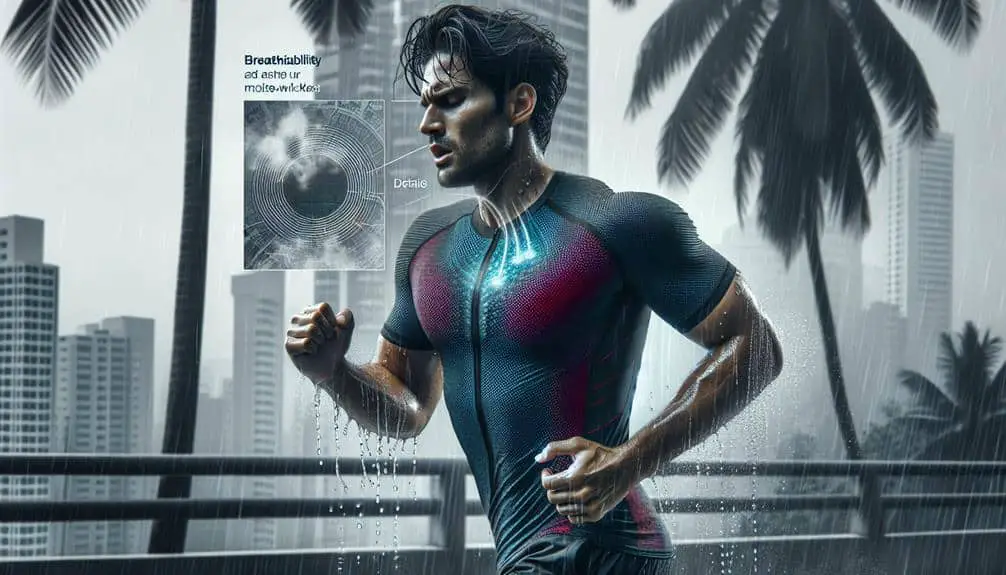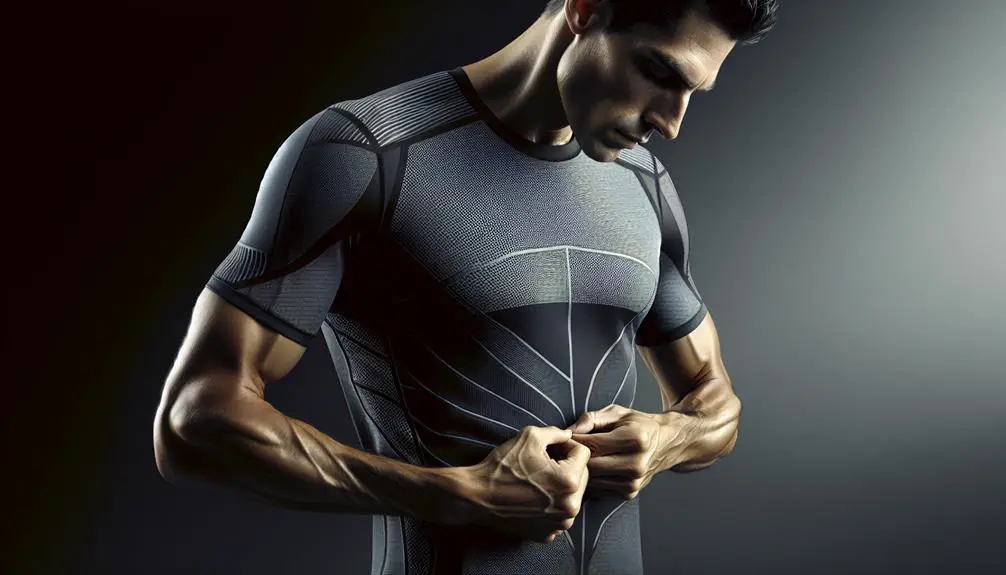To guarantee breathability and moisture control in activewear, opt for fabrics like polyester and nylon for superior moisture-wicking properties. Proper sizing prevents discomfort and chafing during workouts. Look for ventilation features such as mesh panels and underarm vents for increased airflow. Moisture-wicking technology pulls sweat away, preventing chafing. Layer with moisture-wicking base layers and breathable outer shells. Follow washing instructions to maintain fabric performance. Consider materials like polyester and nylon for enhanced breathability. Choosing the right fit and design with strategic ventilation panels is essential. For more expert tips on breathable moisture control activewear, explore further.
Key Points
- Choose moisture-wicking fabrics like polyester and nylon for superior sweat control.
- Opt for well-fitted activewear to enhance performance and comfort during workouts.
- Look for ventilation features such as mesh panels and airflow designs for enhanced breathability.
- Layer with moisture-wicking base, insulating mid, and breathable outer layers for optimal temperature regulation.
- Follow washing instructions to maintain fabric performance and longevity.
Fabric Selection
When choosing activewear fabrics for best breathable moisture control, prioritize those with moisture-wicking properties. Natural fibers like cotton are breathable and comfortable but tend to retain moisture, making them unsuitable for intense workouts. Synthetic blends such as polyester and nylon are excellent choices due to their moisture-wicking abilities. These fabrics pull sweat away from your skin to the outer surface where it can evaporate quickly, keeping you dry and cool during your workout.
Polyester, a popular synthetic fabric, is lightweight, durable, and dries quickly, making it ideal for high-intensity activities. Nylon, another synthetic option, is known for its strength and elasticity, providing flexibility and ease of movement. Blends of polyester and spandex offer a good balance between moisture control and stretch, ensuring a comfortable fit while effectively managing sweat.
Proper Fit
To guarantee peak performance and comfort during your workouts, selecting activewear that fits properly is vital. Proper sizing is essential for activewear to function at its best. When choosing your activewear, make sure that it fits snugly but not too tight. The right fit will prevent chafing and discomfort during movement while providing the necessary support.
Look for activewear that offers a comfortable fit around the waist, shoulders, and legs. Proper sizing also ensures that moisture-wicking properties work effectively by allowing the fabric to come into contact with your skin. A well-fitted garment will enhance your range of motion, making your workouts more efficient.
Before making a purchase, carefully review the size chart provided by the brand to select the most suitable option for your body measurements. Remember, a comfortable fit not only contributes to better performance but also increases your overall satisfaction with your activewear.
Ventilation Features
Make sure that activewear garments incorporate strategic ventilation features to maximize breathability and moisture control during your workouts. When choosing activewear, seek designs that include the following ventilation features:
- Mesh Panels: Strategically positioned mesh panels allow for increased airflow in key sweat zones, assisting in heat dissipation and moisture evaporation.
- Airflow Design: Garments with airflow design elements are designed to promote ventilation and improve air circulation, keeping you cool and dry during vigorous workouts.
- Underarm Vents: Activewear with underarm vents facilitates air exchange, preventing heat buildup and enhancing better breathability.
- Back Ventilation: Search for activewear with back ventilation systems that allow hot air to escape and cool air to enter, maintaining a comfortable body temperature.
- Breathable Fabrics: Choose activewear made from breathable materials that work alongside ventilation features to wick moisture away from the skin and enhance overall comfort.
Incorporating these ventilation features into your activewear will guarantee superior breathability and maximum moisture control, boosting your performance during workouts.
Moisture-Wicking Technology
Maximize moisture control and breathability in your activewear by exploring the innovative benefits of Moisture-Wicking Technology. This advanced technology is designed to enhance sweat management during your workouts, ensuring you stay dry and comfortable.
Moisture-wicking fabrics are engineered to pull moisture away from your skin towards the outer layer of the fabric where it can evaporate quickly. By incorporating these materials into your activewear, you can maintain peak hydration awareness by preventing excessive moisture buildup and reducing the risk of chafing and discomfort.
The key to moisture-wicking technology lies in the fabric's ability to transport sweat efficiently, allowing for enhanced evaporation and overall comfort. When selecting activewear with moisture-wicking properties, look for garments that offer strategic ventilation zones to further enhance breathability and moisture control.
Layering Techniques
Implementing effective layering techniques is crucial for optimizing your activewear's performance in regulating body temperature during varying levels of physical activity. To guarantee efficient sweat management and heat retention, follow these advanced layering tips:
- Base Layer: Start with a moisture-wicking base layer that fits snugly against your skin to draw sweat away and keep you dry.
- Insulating Layer: Add an insulating layer that traps heat while allowing moisture to escape, such as a breathable fleece or down jacket.
- Shell Layer: The outer shell should be windproof and waterproof to protect against external elements while still allowing heat and moisture to dissipate.
- Ventilation Zips: Look for activewear with ventilation zips under the arms or on the back to regulate airflow and prevent overheating.
- Adjustable Features: Opt for garments with adjustable cuffs, hems, and collars to customize ventilation and heat retention based on your activity level and the environmental conditions.
Washing Instructions
When washing your activewear, remember to use a gentle cycle and cold water to prevent damage to the fabric.
Avoid using fabric softeners or bleach, as they can affect the moisture-wicking properties of the material.
Always hang your activewear to dry instead of using a dryer to maintain its shape and functionality.
Proper Washing Techniques
To maintain the quality and longevity of your breathable moisture control activewear, follow these specific washing instructions carefully.
When washing your activewear, remember to:
- Use a gentle cycle: Select the delicate or gentle cycle on your washing machine to prevent excessive agitation.
- Use mild detergent: Opt for a detergent that's gentle on fabrics to avoid damaging the moisture-wicking properties.
- Turn garments inside out: This helps protect the outer surface of the fabric during washing.
- Avoid fabric softeners: Fabric softeners can clog the fabric's pores, reducing its moisture-wicking abilities.
- Wash with like fabrics: Separate your activewear from rough fabrics like denim to prevent friction damage.
Drying Recommendations
For prime care of your breathable moisture control activewear, adhere to these recommended drying techniques. To maintain the quality of your activewear, opt for air drying whenever possible. Hang your garments in a well-ventilated area away from direct sunlight to prevent any potential fabric damage.
Air drying helps preserve the elasticity and overall structure of the material, ensuring a longer lifespan for your activewear. If time is of the essence, quick drying in a dryer on a low heat setting is acceptable. However, be cautious not to expose your activewear to high heat for extended periods, as this can lead to shrinkage and deterioration of the fabric.
Choosing the Right Brands
Selecting the appropriate brands for breathable moisture control activewear is crucial for ensuring high-quality performance and comfort during your workouts. When choosing the right brands, consider the following:
- Brand Comparison: Compare different brands known for their moisture-wicking and breathable activewear to find the best fit for your needs.
- Price Range: Look for brands that offer quality activewear within your budget to make sure you get the best value for your money.
- Customer Reviews: Check customer reviews and ratings to gain insights into the performance and durability of the activewear from a particular brand.
- Sizing Chart: Always refer to the brand's sizing chart to make sure you select the right size for ideal comfort and performance.
- Material Composition: Consider the materials used by different brands as some fabrics may offer better moisture control and breathability than others.
Frequently Asked Questions
How Do I Prevent Chafing While Wearing Moisture Control Activewear?
To prevent chafing while wearing moisture control activewear, focus on proper sweat management. Choose seamless garments with moisture-wicking fabrics. Apply anti-chafing balms to high-friction areas. Confirm a snug but not tight fit to reduce friction. Stay dry and comfortable during your workouts.
Are There Any Specific Activewear Materials That Are Better for High-Intensity Workouts?
When it comes to high-intensity workouts, fabric selection is key. Opt for materials that prioritize breathability and sweat-wicking properties. These features enhance performance benefits by keeping you dry and comfortable throughout your rigorous exercise routine.
Can Moisture Control Activewear Help With Body Odor?
Moisture control activewear can aid with body odor by incorporating odor control and antibacterial properties. These features help to minimize the growth of odor-causing bacteria, ensuring a fresh and comfortable workout experience.
Are There Any Specific Care Instructions for Storing Moisture Control Activewear?
To properly store moisture control activewear, make sure it's clean and dry before storing. Avoid direct sunlight or heat. Fold rather than hang to prevent stretching. Keep in a cool, dry place to maintain fabric integrity.
How Can I Tell if My Activewear Is No Longer Effective at Moisture Control?
When your activewear starts feeling like a damp sponge, that's a sign it's no longer effective at moisture control. Look for indicators like reduced breathability and persistent wetness. It's time for a replacement.


